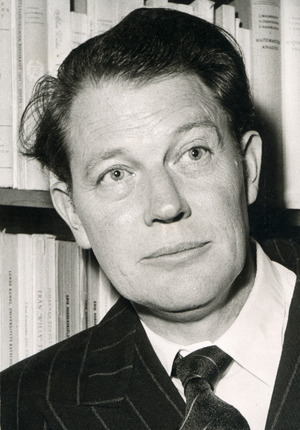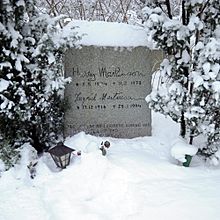Harry Martinson facts for kids
Quick facts for kids
Harry Martinson
|
|
|---|---|

Harry Martinson
|
|
| Born | 6 May 1904 Jämshög, Sweden |
| Died | 11 February 1978 (aged 73) Stockholm, Sweden |
| Notable awards | Nobel Prize in Literature 1974 (shared with Eyvind Johnson) |
| Spouses | Moa Martinson (1929–1940) Ingrid Lindcrantz (1942–1978) |
Harry Martinson (6 May 1904 – 11 February 1978) was a Swedish writer, poet and former sailor. In 1949 he was elected into the Swedish Academy. He was awarded a joint Nobel Prize in Literature in 1974 together with fellow Swede Eyvind Johnson "for writings that catch the dewdrop and reflect the cosmos". The choice was controversial, as both Martinson and Johnson were members of the academy.
He has been called "the great reformer of 20th-century Swedish poetry, the most original of the writers called 'proletarian'."
Life
Martinson was born in Jämshög, Blekinge County in south-eastern Sweden. At a young age he lost both his parents, his father died of tuberculosis in 1910 and a year later his mother emigrated to Portland, Oregon leaving behind her children, whereafter Martinson was placed as a foster child (Kommunalbarn) in the Swedish countryside. At the age of sixteen Martinson ran away and signed onto a ship to spend the next years sailing around the world visiting countries including Brazil and India.
A few years later lung problems forced him to set ashore in Sweden where he travelled around without a steady employment, at times living as a vagabond on country roads. At the age of 21, he was arrested for vagrancy in Lundagård park, Lund.
In 1929, he debuted as a poet. Together with Artur Lundkvist, Gustav Sandgren, Erik Asklund and Josef Kjellgren he authored the anthology Fem unga (Five Youths), which introduced Swedish modernism. His poetry, characterized by linguistic innovation and a frequent use of metaphors, combined an acute eye for, and love of nature, with a deeply felt humanism. His popular success as a novelist came with the semi-autobiographical Nässlorna blomma (Flowering Nettle) in 1935, about hardships encountered by a young boy in the countryside. It has since been translated into more than thirty languages. The novel Vägen till Klockrike (The Road to Klockrike, 1948) was another huge success, and in 1949 Martinson became the first proletarian writer to be elected a member of the Swedish Academy.
One of his most noted works is the poetic cycle Aniara, which is a story of the spacecraft Aniara that during a journey through space loses its course and subsequently floats on without destination. The book was published in 1956 and became an opera in 1959 composed by Karl-Birger Blomdahl. The cycle has been described as "an epic story of man's fragility and folly".
From 1929 to 1940, he was married to novelist Moa Martinson, prominent as a feminist and proletarian author, whom he met through a Stockholm anarchist newspaper, Brand. He travelled to the Soviet Union in 1934. He and Moa were divorced due to her criticism of his lack of political commitment. Harry married Ingrid Lindcrantz (1916–1994) in 1942.
Writing
Harry Martinson debuted in 1929 with the collection of poems Spökskepp (Ghost Ship), that for the most part employed motifs of the ocean and life as a seaman. The same year he contributed to anthology Fem unga, a ground-breaking and highly influential book in modernist Swedish literature. Martinson's major breakthrough was his 1931 poetry collection Nomad. His poetry was noted for rich imagery with precise observations that emphazised details. In the books Resor utan mål (Aimless journeys, 1932) and Kap Farväl! (1933; English translation Cape Farewell, 1934) Martinson recalled memories of his life as a seaman. In his later writing nature and the earth became increasingly important motifs. During the 1930s he developed a mastery in describing nature in both prose and poetry and was especially noted for his short nature poems with precise observations. In the autobiographical novels Nässlorna blomma (Flowering Nettle, 1935) and Vägen ut (The Way Out, 1936) Martinson tells about his childhood. Martinson had a strong interest in science which was a prominent influence in his work. In his book Verklighet till döds (Reality to Death, 1940) written during World War II Martinson criticized contemporary social conditions and technological development. Criticism of modern culture is also a theme in Martinson's philosophical vagabond novel Vägen till Klockrike (1948; English translation The Road, 1950) and the collection of poems Passad (1945).
In his later writing Martinson developed a new major theme based on his increasing interest in outer space and the cosmic. This came to most distinct expression in Aniara (1956), a poetic space epic that became Martinson's best known work. In his late work criticism of modern life and its technology came to an even stronger expression in his 1960 poetry collection Vagnen (The Wagon), which unlike his previous books was not well received by contemporary critics. Sensitive to criticism it appeared to be Martinson's last published collection of poems, but in 1971 he returned with Dikter om ljus och mörker (Poems of Light and Darkness), which was followed by a collection of nature poems Tuvor (Tufts) in 1973.
Legacy
Martinson is widely regarded as the greatest Swedish author since August Strindberg. The 100th anniversary of Martinson's birth was celebrated around Sweden in 2004. The Cikada Prize is awarded in memory of Harry Martinson since that year. The Harry Martinson Society was founded in 1984 and awards the Harry Martinson Prize to individuals or organisations working in the spirit of Harry Martinson. The Swedish Academy awards a scholarship in memory of Harry Martinson to an author writing in Swedish.
See also
 In Spanish: Harry Martinson para niños
In Spanish: Harry Martinson para niños


